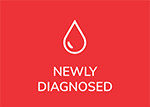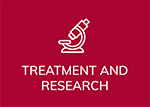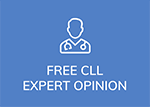
Chronic Lymphocytic Leukemia (CLL) is a very unique type of cancer. It is usually slow to progress, it sometimes has no initial symptoms, and more often than not, it does not require immediate treatment. When you are learning about CLL, you often hear that you should go and see a ‘specialist’ in CLL. I can tell you from personal experience, that this is a MUST. A CLL specialist has to be part of your TEAM.
My CLL journey is not unlike many others. I was diagnosed initially by my primary care physician, who noticed a rise in my white blood count (WBC) over a period of 3 years. Nothing dramatic, and not even out of ‘normal’ range, but still, he was concerned. He referred me to local, well-respected hematologist / oncologist, who ran a flow cytometry and confirmed that I had CLL. I was seen by him every 6 months for 6 years, but as my counts and my symptoms increased and he began seeing me every 3 months, then every month. We had talked about treatments and the only two options he gave me were a transplant (which he didn’t recommend) and FCR (Fludarabine/Cyclophosphamide/Rituximab). At the time, I had done little research because my disease had been indolent for so long. I also had not seen a CLL specialist. BOTH BIG MISTAKES!
Within a few months, my B symptoms increased dramatically and my counts doubled. I had literally fallen off the cliff in just two months. I had night sweats, extreme fatigue and enlarged lymph nodes and spleen. At the time of my first treatment, my WBC had risen to over 500,000. At that point, I should have been more prepared, but wound up like many people, being told by my doctor what was the next step. He should have noticed that my hemoglobin was hovering around 6, which was significant, but he ignored that particular symptom. He just kept transfusing me with packed red blood cells and continued the FCR treatment. When my wife, who is an RN, asked about autoimmune hemolytic anemia (AIHA) as something to be considered, he told her no, it was just the CLL and the treatment and everything was fine. She asked him if he had run a Coombs test to confirm this. She was told, that yes, he ran it, but couldn’t find the results. She was so frustrated that she emailed the late Dr. Terry Hamblin with my symptoms and he confirmed (OVER EMAIL) that I most likely had AIHA and that I needed to be treated for that immediately. During these weeks, we had requested an appointment with Dr. Tom Kipps at UCSD, a CLL specialist. After my wife faxed him my lab work, we got in to see him in less than 2 weeks.
My first visit with Dr. Kipps was an adventure. I was unable to drive because my fatigue was so severe. I barely made it to the lab for blood work. After I got in to see Dr. Kipps, he wanted to re-run my labs because they were so far out of normal range, so we ran them again. It confirmed my hemoglobin was at 4.6, that I definitely had AIHA and that at that level of hemoglobin, my major organs were shutting down because they were not getting any oxygen. He told me that right then my CLL would not kill me, but the AIHA would, if left untreated. He said that he was glad I saw him because if I had not come in I would probably have died in less than 48 hours from cardiac arrest. He then asked me if I had any plans for the rest of the day. I told him that I was just planning to celebrate my 60th birthday the next day. He said that he was admitting me to the hospital immediately. His nurse put me in a wheelchair and took me to the hospital where I received 4 units of blood, plus steroids. That day began a 2 1/2 year ordeal just to treat my AIHA. I don’t believe that I would be alive today if I had not seen a CLL specialist. That day, Dr. Kipps became my CLL doctor.
After this experience, I became a crusader for CLL patients to see a CLL specialist, even if they were Watch and Wait, and even if they have no REAL symptoms. You need to have someone that truly understands CLL. You need to have someone that understands what to do when a patient ‘falls off the cliff’ suddenly. Usually it takes months to get in to see a CLL specialist for the FIRST appointment. This is another reason to set up this relationship early in your diagnosis. The ideal situation is to have a local oncologist that ‘plays well’ with a CLL specialist. This might take some work on your part ‘interviewing’ local hematologists to make sure you all can have a good working relationship. The main reason for having a local hematologist as a part of your team is that CLL specialists are not always accessible like a local hematologist. They are doing research, or off speaking and attending conferences all over the world. Typically, they only schedule appointments with patients one or two days a week. It is not always easy to get a hold of them if you need an immediate answer. That is where the local hematologist comes in as someone you can call and get an answer in a timely manner.
Another reason to see a CLL specialist is that they usually work in a TEAM environment. This is true for many of the specialists at UCSD, Ohio State, University of California at Irvine, MD Anderson, and New York Presbyterian, to name a few. These institutions are growing the next generation of CLL specialists and decisions made regarding unusually tough cases are usually a group effort, hence you are not relying on just ONE person to make decisions about your care.
Access to Clinical Trials is another reason to see a specialist. I have been involved in two clinical trials and both of them had positive outcomes (even though my remission in the first one only lasted 18 months). Most local hematologists don’t have access to clinical trials and most clinical trials are run by CLL specialists or their institutions. The level of care that I received during my clinical trials was outstanding. You may have more blood tests or CT Scans than you want, but the trial team are always on top of things and can react very quickly in that environment.
While a local hematologist may only have knowledge or experience with one or two treatment options, a CLL specialist usually has experience with many options, including the NEWEST therapies. This is not only critical in making the decision for your FIRST treatment, but also if you have become relapsed / refractory and need second or third treatments. In our Orange County California CLL Society Support group, there are over 30 active members and no one in our group has been on the same treatment path. There are so many variables with CLL that it is difficult to have experience with all of them. That is why a CLL specialist is so important. Through our experiences and education we have convinced all of the members of our group to include a specialist as a part of their team.
If all of these reasons are not enough to convince you to see a specialist, then look at the numbers. There are approximately 18,000 oncologists / hematologists in the United States and there are about 18,000 new cases of CLL diagnosed every year. This means, on average, a local hematologist will see ONE CLL patient per year. Wouldn’t you want to see a CLL specialist that has hundreds of CLL patients as a part of his or her practice?
One last thought is a study done by the Mayo Clinic in 2012 that tried to determine the impact of treatment of patients by disease specific physicians. It concluded that ‘Physician disease-specific expertise appears to influence outcome in patients with CLL / SLL even when seen in the setting of an academic center… To the greatest extent possible, patients should be cared for by a board certified hematologist/oncologist expert in the care of their specific malignancy. When not possible, practice guidelines developed by disease-specific experts should be followed.’ You can read the entire report at the following link: Mayo Clinic Study
In June, 2000, through a routine blood test I was diagnosed with Chronic Lymphocytic Leukemia. I was watch and wait for over seven years. During this time I had blood tests every six months, and check-ups by a very qualified local hematologist to make sure I didn’t have any other ‘B’ symptoms like swollen lymph nodes, night sweats, fatigue or weight loss. During those seven years I had minimal symptoms and the major issue was my increasing white blood count (WBC), which by September 2007 had increased to over 600,000. People with poor prognostic markers, like 11q deleted 17p, ZAP 70 positive, and unmutated have a much poorer prognosis. I have ALL of these makers and here I still am. Based on OLD statistics I had about 5-7 years of life left when I was diagnosed in 2000. Now, 14 years later I am still going strong, and expect to be here another 14.
Originally published in The CLL Tribune Q2 2016.

















